2016 TOYOTA MIRAI fuel cap
[x] Cancel search: fuel capPage 15 of 464

15Pictorial index
MIRAI_OM_USA_OM62004UWindshield wipers . . . . . . . . . . . . . . . . . . . . . . . . . . . . . . . . . P. 195
Precautions against winter season . . . . . . . . . . . . . . . . . . . . . P. 253
To prevent freezing (windshield wiper de-icer). . . . . . . . . . . . . P. 261
Precautions against car wash . . . . . . . . . . . . . . . . . . . . . . . . . P. 308
Fuel door . . . . . . . . . . . . . . . . . . . . . . . . . . . . . . . . . . . . . . . . P. 198
Refueling method. . . . . . . . . . . . . . . . . . . . . . . . . . . . . . . . . . . P. 198
Fuel type/hydrogen tanks’ fuel capacity . . . . . . . . . . . . . . . . . . P. 418
Tires . . . . . . . . . . . . . . . . . . . . . . . . . . . . . . . . . . . . . . . . . . P. 332
Tire size/inflation pressure . . . . . . . . . . . . . . . . . . . . . . . . . P. 421
Winter tires/tire chains . . . . . . . . . . . . . . . . . . . . . . . . . . . . P. 253
Checking/rotation/tire pressure warning system . . . . . . . . . P. 332
Coping with flat tires . . . . . . . . . . . . . . . . . . . . . . . . . . . . . . P. 381
Hood . . . . . . . . . . . . . . . . . . . . . . . . . . . . . . . . . . . . . . . . . . . . P. 320
Opening . . . . . . . . . . . . . . . . . . . . . . . . . . . . . . . . . . . . . . . . . . P. 320
Coping with overheat . . . . . . . . . . . . . . . . . . . . . . . . . . . . . . . . P. 406
Warning message . . . . . . . . . . . . . . . . . . . . . . . . . . . . . . . . . . P. 376
Headlights. . . . . . . . . . . . . . . . . . . . . . . . . . . . . . . . . . . . . . . . P. 187
Parking lights/daytime running lights . . . . . . . . . . . . . . . . . P. 187
Turn signal lights . . . . . . . . . . . . . . . . . . . . . . . . . . . . . . . . . . P. 185
Tail lights . . . . . . . . . . . . . . . . . . . . . . . . . . . . . . . . . . . . . . . . P. 187
Stop lights
License plate lights . . . . . . . . . . . . . . . . . . . . . . . . . . . . . . . . P. 187
Back-up lights
Shifting the shift position to R . . . . . . . . . . . . . . . . . . . . . . . . . P. 179
Side marker lights . . . . . . . . . . . . . . . . . . . . . . . . . . . . . . . . . P. 187
4
5
6
7
Light bulbs of the exterior lights for driving
(Replacing method: P. 358)
8
9
10
11
12
13
14
15
Page 90 of 464
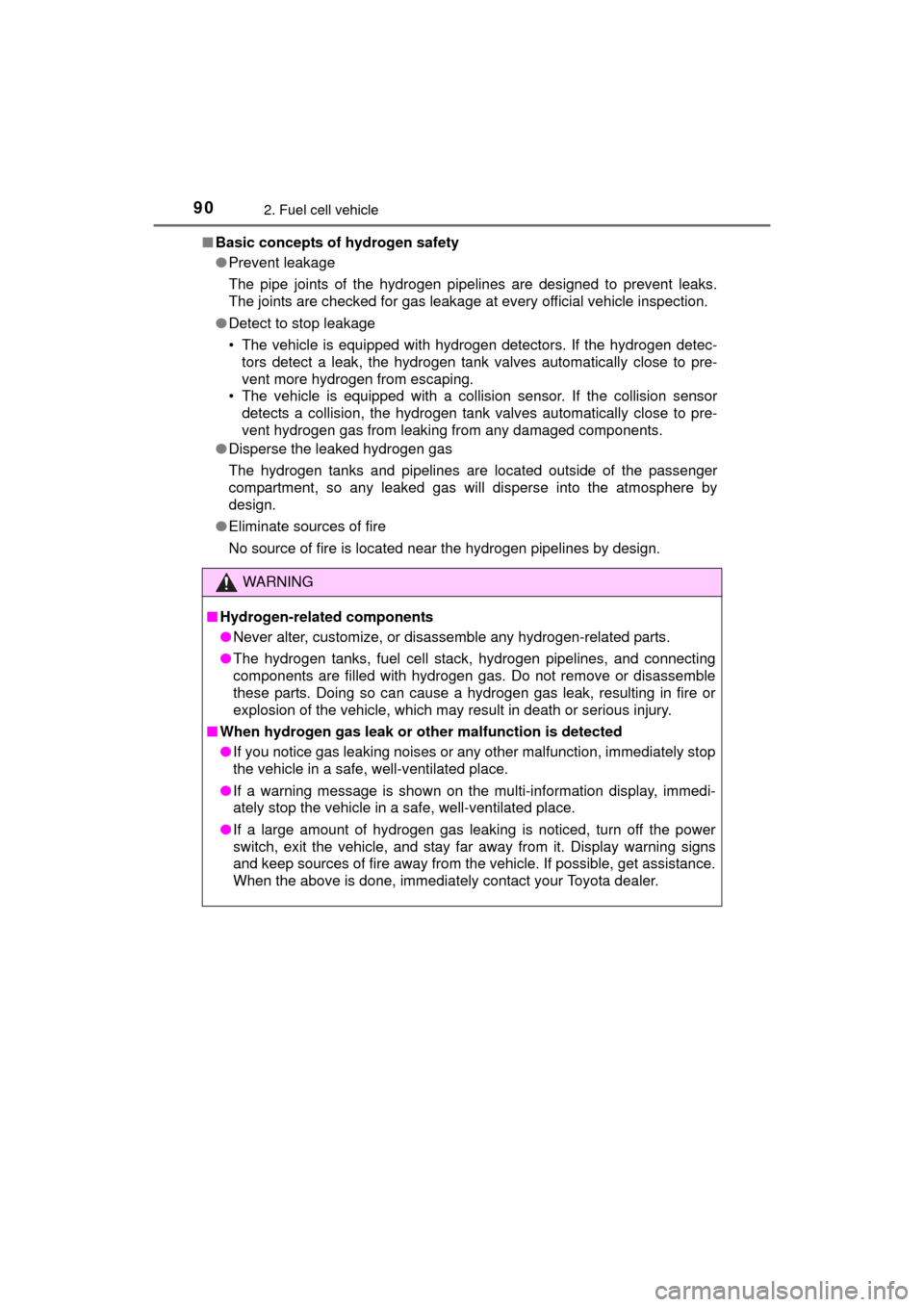
902. Fuel cell vehicle
MIRAI_OM_USA_OM62004U■
Basic concepts of hydrogen safety
●Prevent leakage
The pipe joints of the hydrogen pipelines are designed to prevent leaks.
The joints are checked for gas leakage at every official vehicle inspection.
● Detect to stop leakage
• The vehicle is equipped with hydrogen detectors. If the hydrogen detec-
tors detect a leak, the hydrogen tank valves automatically close to pre-
vent more hydrogen from escaping.
• The vehicle is equipped with a collision sensor. If the collision sensor
detects a collision, the hydrogen tank valves automatically close to pre-
vent hydrogen gas from leaking from any damaged components.
● Disperse the leaked hydrogen gas
The hydrogen tanks and pipelines are located outside of the passenger
compartment, so any leaked gas will disperse into the atmosphere by
design.
● Eliminate sources of fire
No source of fire is located near the hydrogen pipelines by design.
WARNING
■ Hydrogen-related components
●Never alter, customize, or disassemble any hydrogen-related parts.
● The hydrogen tanks, fuel cell stack, hydrogen pipelines, and connecting
components are filled with hydrogen gas. Do not remove or disassemble
these parts. Doing so can cause a hydrogen gas leak, resulting in fire or
explosion of the vehicle, which may result in death or serious injury.
■ When hydrogen gas leak or ot her malfunction is detected
● If you notice gas leaking noises or any other malfunction, immediately stop
the vehicle in a safe, well-ventilated place.
● If a warning message is shown on the multi-information display, immedi-
ately stop the vehicle in a safe, well-ventilated place.
● If a large amount of hydrogen gas leaking is noticed, turn off the power
switch, exit the vehicle, and stay far away from it. Display warning signs
and keep sources of fire away from the vehicle. If possible, get assistance.
When the above is done, immediately contact your Toyota dealer.
Page 159 of 464
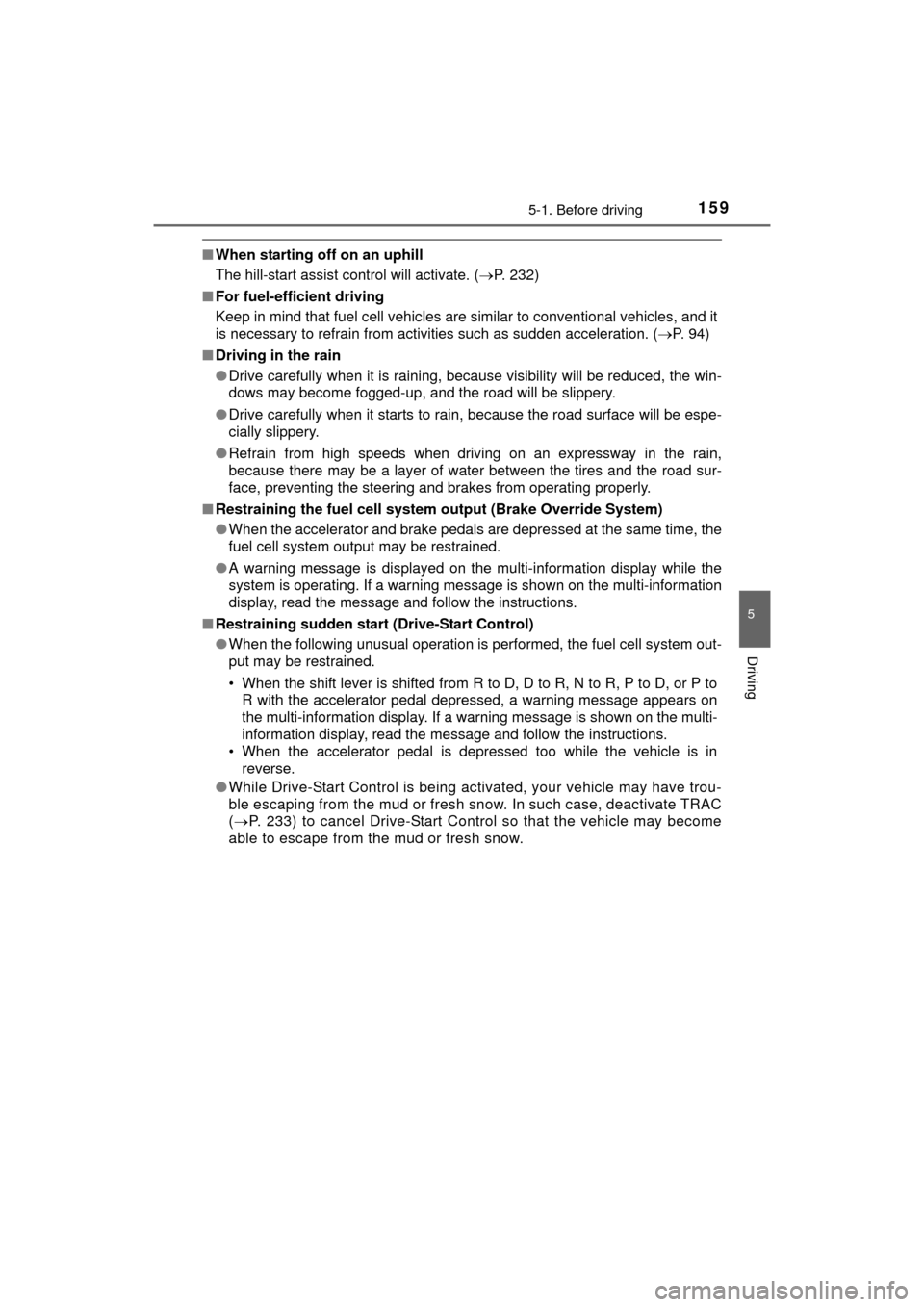
1595-1. Before driving
5
Driving
MIRAI_OM_USA_OM62004U
■When starting off on an uphill
The hill-start assist control will activate. ( P. 232)
■ For fuel-efficient driving
Keep in mind that fuel cell vehicles are similar to conventional vehicles, and it
is necessary to refrain from activities such as sudden acceleration. ( P. 94)
■ Driving in the rain
●Drive carefully when it is raining, because visibility will be reduced, the win-
dows may become fogged-up, and the road will be slippery.
● Drive carefully when it starts to rain, because the road surface will be espe-
cially slippery.
● Refrain from high speeds when driving on an expressway in the rain,
because there may be a layer of water between the tires and the road sur-
face, preventing the steering and brakes from operating properly.
■ Restraining the fuel cell system output (Brake Override System)
● When the accelerator and brake pedals are depressed at the same time, the
fuel cell system output may be restrained.
● A warning message is displayed on the multi-information display while the
system is operating. If a warning message is shown on the multi-information
display, read the message and follow the instructions.
■ Restraining sudden start (Drive-Start Control)
●When the following unusual operation is performed, the fuel cell system out-
put may be restrained.
• When the shift lever is shifted from R to D, D to R, N to R, P to D, or P to
R with the accelerator pedal depressed, a warning message appears on
the multi-information display. If a warning message is shown on the multi-
information display, read the message and follow the instructions.
• When the accelerator pedal is depressed too while the vehicle is in
reverse.
● While Drive-Start Control is being activated, your vehicle may have trou-
ble escaping from the mud or fresh snow. In such case, deactivate TRAC
( P. 233) to cancel Drive-Start Control so that the vehicle may become
able to escape from the mud or fresh snow.
Page 162 of 464

1625-1. Before driving
MIRAI_OM_USA_OM62004U
WARNING
Observe the following precautions.
Failure to do so may result in death or serious injury.
■When driving the vehicle
●Do not drive in excess of the speed limit. Even if the legal speed limit per-
mits it, do not drive over 85 mph ( 140 km/h) unless your vehicle has high-
speed capability tires. Driving over 85 mph (140 km/h) may result in tire
failure, loss of control and possible injury. Be sure to consult a tire dealer
to determine whether the tires on y our vehicle are high-speed capability
tires or not before driving at such speeds.
■ When driving on slippery road surfaces
●Sudden braking, acceleration and steering may cause tire slippage and
reduce your ability to control the vehicle.
● Sudden acceleration or regenerative braking due to shifting could cause
the vehicle to skid.
● After driving through a puddle, lightly depress the brake pedal to make
sure that the brakes are functioning properly. Wet brake pads may prevent
the brakes from functioning properly. If the brakes on only one side are wet
and not functioning properly, steering control may be affected.
■ When changing the shift position
●Do not let the vehicle roll backward while a forward driving position is
selected, or roll forward while the shift position is in R.
Doing so may result in an accident or damage to the vehicle.
● Do not shift the shift position to P while the vehicle is moving.
Doing so can damage the transmission and may result in a loss of vehicle
control.
● Do not shift the shift position to R while the vehicle is moving forward.
Doing so can damage the transmission and may result in a loss of vehicle
control.
● Do not shift the shift position to a driving position while the vehicle is mov-
ing backward.
Doing so can damage the transmission and may result in a loss of vehicle
control.
● Shifting the shift position to N while the vehicle is moving will disengage
the fuel cell system. Regenerative braking is not available with the fuel cell
system disengaged.
● Be careful not to shift the shift position with the accelerator pedal
depressed. Shifting the shift position to any position other than P or N may
lead to unexpected rapid acceleration of the vehicle that may cause an
accident and result in death or serious injury.
After shifting the shift position, make sure to check the current shift posi-
tion using the shift position indicator. ( P. 179)
Page 199 of 464

1995-4. Refueling
5
Driving
MIRAI_OM_USA_OM62004U
WARNING
■When filling
Observe the following precautions while fueling the vehicle.
Failure to do so may result in death or serious injury.
●Turn the power switch off before fueling.
● Ensure the hydrogen gas nozzle is locked onto the vehicle receptacle
before filling. This can be done by pulling on the hydrogen gas nozzle to
check that it cannot be pulled off.
Failure to do so may result in injury or damage to the hydrogen gas nozzle
or vehicle.
● Do not smoke while fueling.
● Because the fuel is cold, the hydrogen gas nozzle and vehicle receptacle
surface will become cold, and frost may develop. After fueling is com-
pleted, remove the hydrogen gas nozzle by the plastic handle only. Do not
touch any other parts of the hydrogen gas nozzle or vehicle receptacle
with bare hands immediately after f ueling, as frostbite may occur.
NOTICE
■When filling
●Fuel only with compressed hydrogen gas at stations compliant with the
Society of Automotive Engineers (SAE) J2601 fueling protocol or laws that
may supersede such SAE protocols.
If improper fuels are used, the fuel cell stack will be damaged.
● Do not swing or drop the hydrogen gas nozzle, or subject it to a large
amount of force. Doing so may cause damage.
● If the hydrogen gas nozzle cannot be removed after fueling, it may be fro-
zen to the vehicle receptacle. Wait for the hydrogen gas nozzle to thaw
before attempting to remove. Do not pull or rotate the hydrogen gas nozzle
forcibly. Failure to follow these precautions may cause damage.
● Be sure to replace the cap after filling. If foreign material gets in the vehicle
receptacle, it may cause damage.
● Do not put anything sharp, such as a screwdriver, blade, or any foreign
object into the mouth of the vehicle receptacle. If the vehicle receptacle is
damaged, hydrogen gas may leak during fueling.
● If you notice anything unusual about the vehicle receptacle, please notify
your Toyota dealer.
● If you notice anything unusual with the hydrogen dispenser or hydrogen
gas nozzle, please notify the hydrogen station operator. Contact informa-
tion is usually displayed on the dispenser.
Page 200 of 464
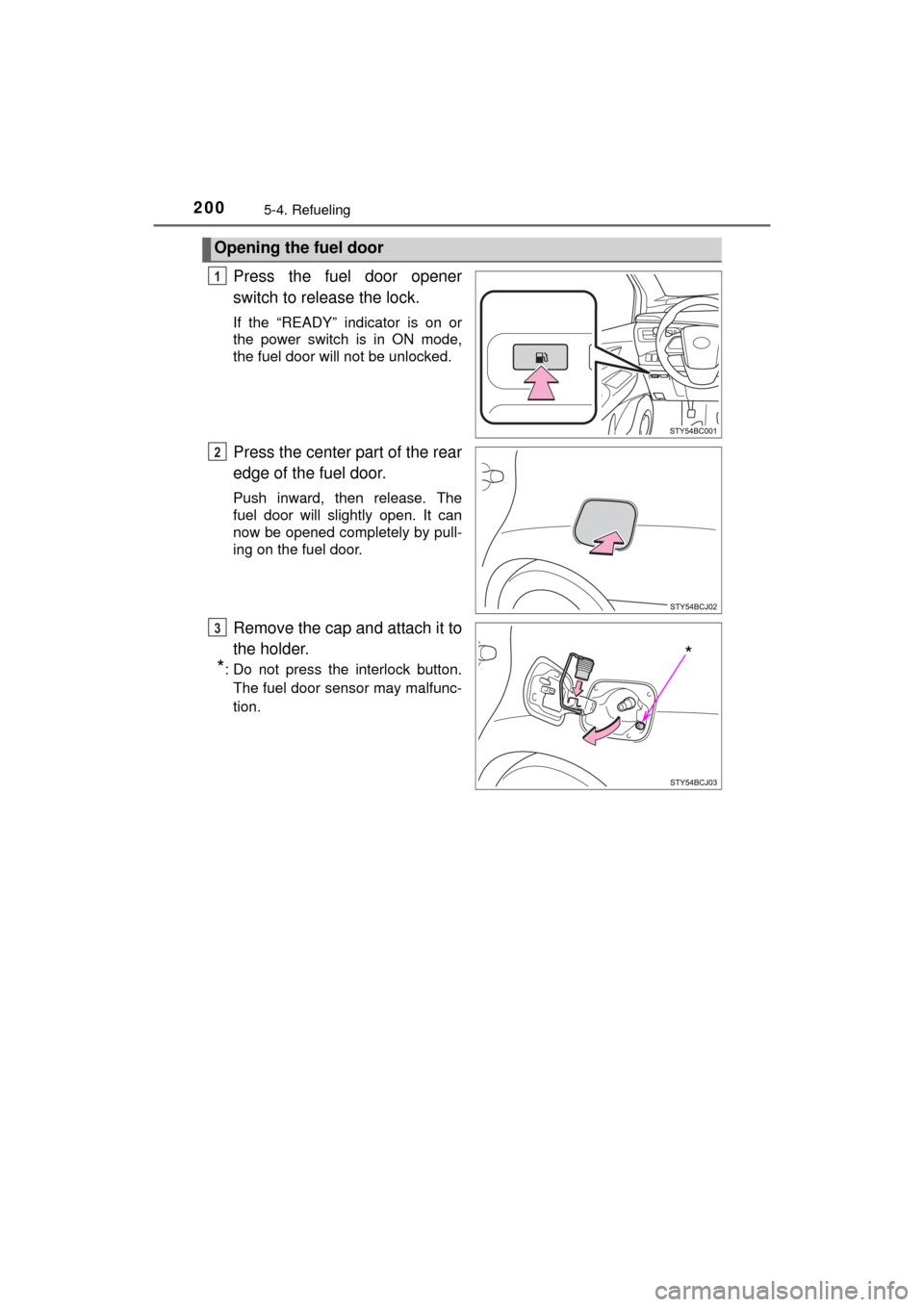
2005-4. Refueling
MIRAI_OM_USA_OM62004U
Press the fuel door opener
switch to release the lock.
If the “READY” indicator is on or
the power switch is in ON mode,
the fuel door will not be unlocked.
Press the center part of the rear
edge of the fuel door.
Push inward, then release. The
fuel door will slightly open. It can
now be opened completely by pull-
ing on the fuel door.
Remove the cap and attach it to
the holder.
*: Do not press the interlock button.The fuel door sensor may malfunc-
tion.
Opening the fuel door
1
2
*
3
Page 201 of 464
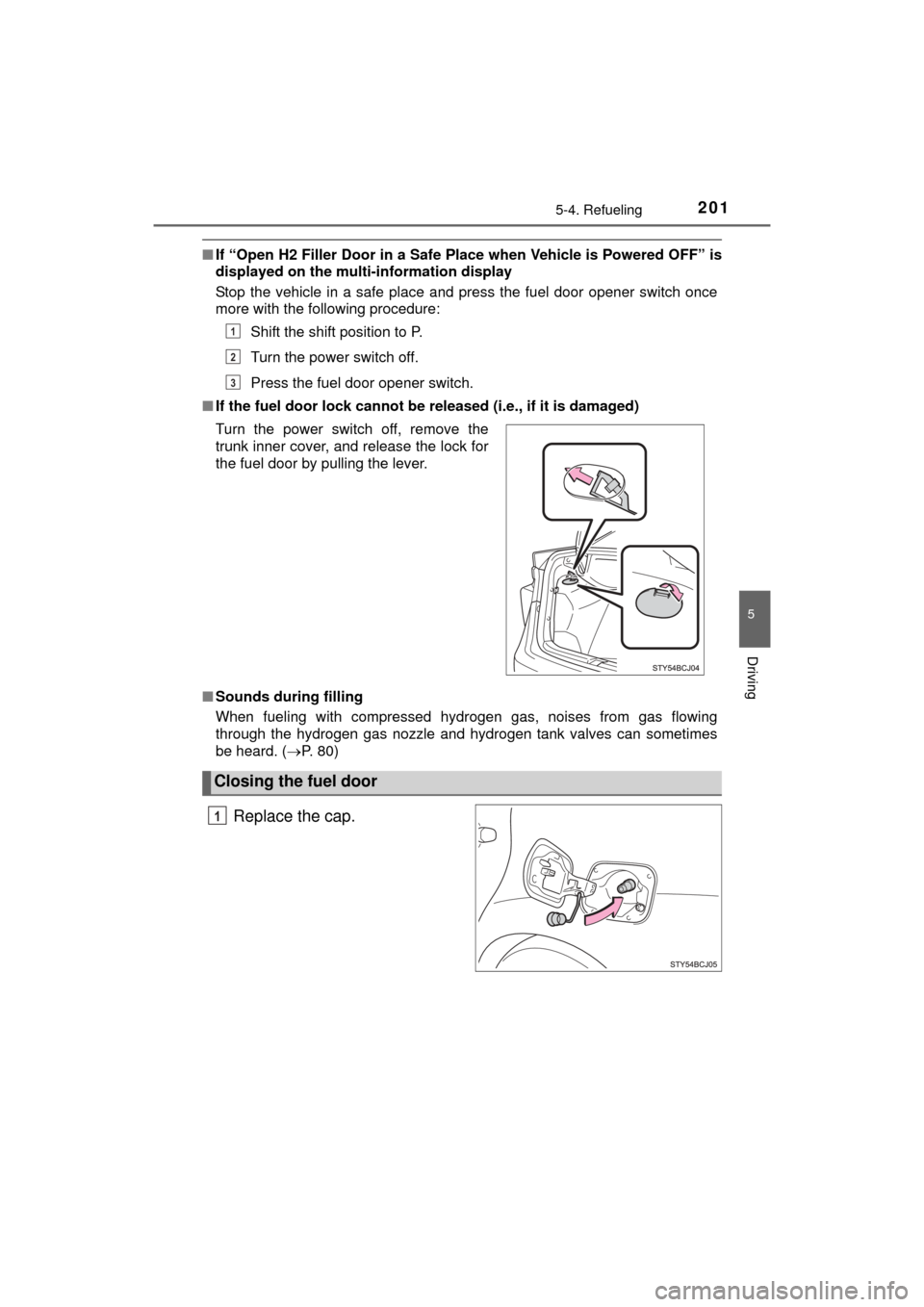
2015-4. Refueling
5
Driving
MIRAI_OM_USA_OM62004U
■If “Open H2 Filler Door in a Safe Place when Vehicle is Powered OFF” is
displayed on the mult i-information display
Stop the vehicle in a safe place and press the fuel door opener switch once
more with the following procedure:
Shift the shift position to P.
Turn the power switch off.
Press the fuel door opener switch.
■ If the fuel door lock cannot be released (i.e., if it is damaged)
■ Sounds during filling
When fueling with compressed hydrogen gas, noises from gas flowing
through the hydrogen gas nozzle and hydrogen tank valves can sometimes
be heard. ( P. 80)
Replace the cap.
Turn the power switch off, remove the
trunk inner cover, and release the lock for
the fuel door by pulling the lever.
Closing the fuel door
1
2
3
1
Page 202 of 464
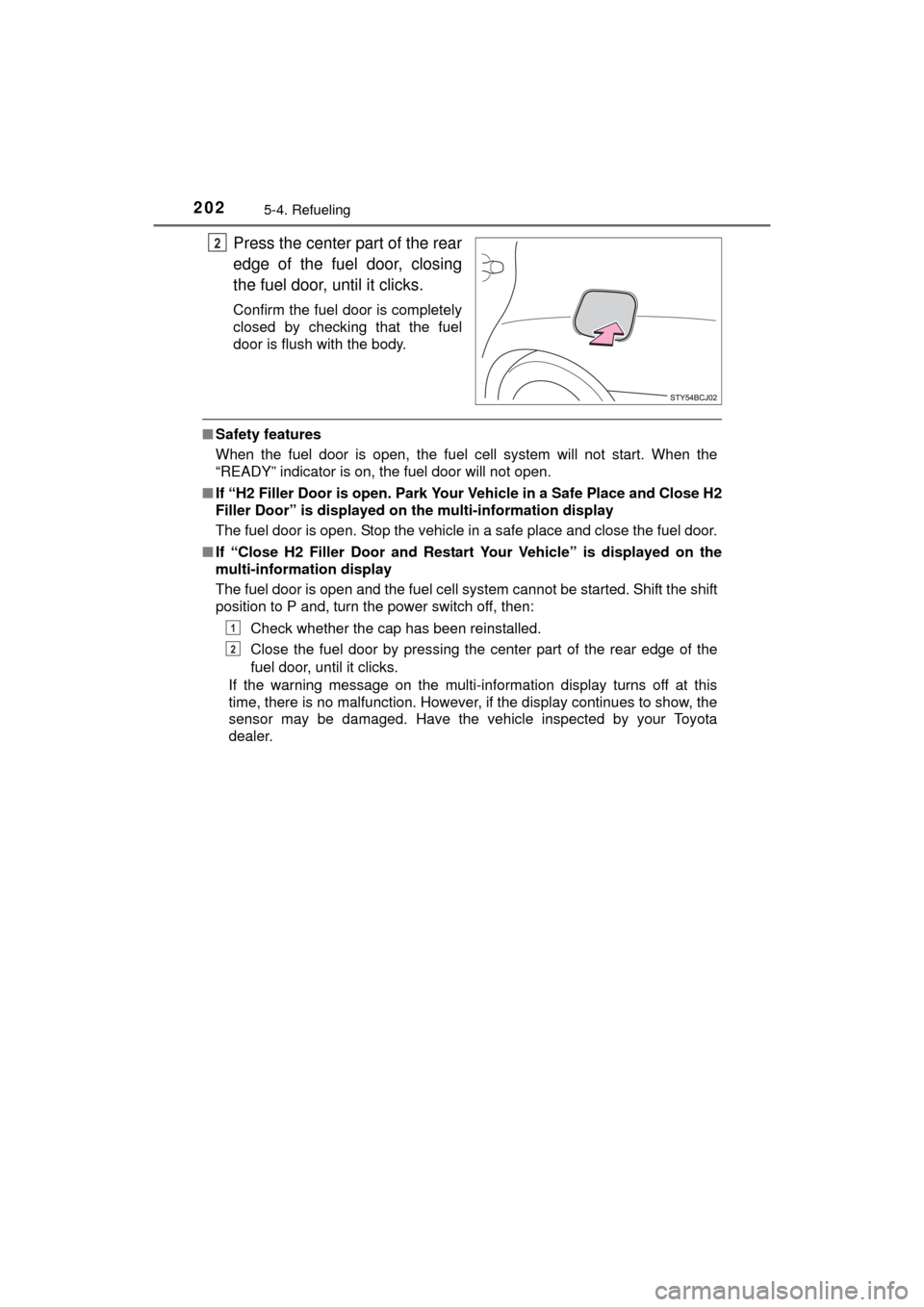
2025-4. Refueling
MIRAI_OM_USA_OM62004U
Press the center part of the rear
edge of the fuel door, closing
the fuel door, until it clicks.
Confirm the fuel door is completely
closed by checking that the fuel
door is flush with the body.
■Safety features
When the fuel door is open, the fuel cell system will not start. When the
“READY” indicator is on, the fuel door will not open.
■ If “H2 Filler Door is open. Park Your Vehicle in a Safe Place and Close H2
Filler Door” is displayed on the multi-information display
The fuel door is open. Stop the vehicle in a safe place and close the fuel door.
■ If “Close H2 Filler Door and Restart Your Vehicle” is displayed on the
multi-information display
The fuel door is open and the fuel cell system cannot be started. Shift the shift
position to P and, turn the power switch off, then:
Check whether the cap has been reinstalled.
Close the fuel door by pressing the center part of the rear edge of the
fuel door, until it clicks.
If the warning message on the multi-information display turns off at this
time, there is no malfunction. However, if the display continues to show, the
sensor may be damaged. Have the vehicle inspected by your Toyota
dealer.
2
1
2